

Welcoming oslo.policy into the OpenStack Oslo family - IBM OpenTech. Welcome OpenStack Oslo’s newest addition to the family, oslo.policy!
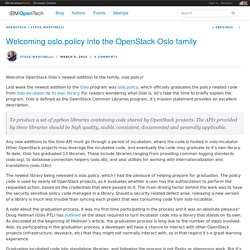
Last week the newest addition to the Oslo program was oslo.policy, which officially graduates the policy related code from oslo-incubator to its own library. For readers wondering what Oslo is, let’s take the time to briefly explain the program. Oslo is defined as the OpenStack Common Libraries program, it’s mission statement provides an excellent description. To produce a set of python libraries containing code shared by OpenStack projects.
The APIs provided by these libraries should be high quality, stable, consistent, documented and generally applicable. Optimizing Node.js Application Concurrency. Concurrency node performance Table of Contents Node has a limited ability to scale to different container sizes.
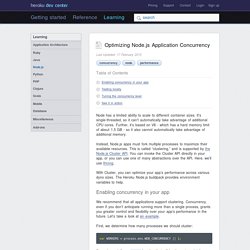
It’s single-threaded, so it can’t automatically take advantage of additional CPU cores. Further, it’s based on V8 - which has a hard memory limit of about 1.5 GB - so it also cannot automatically take advantage of additional memory. Instead, Node.js apps must fork multiple processes to maximize their available resources. With Cluster, you can optimize your app’s performance across various dyno sizes. Enabling concurrency in your app We recommend that all applications support clustering. Docker: Sorry, you're just going to have to learn about it. Today we begin. Sysadmin Blog Docker, meet hype.

How to manage your OpenStack projects using keystone domains in Havana - Pure Play OpenStack. In OpenStack, domains are how you to aggregate projects, or tenants in Grizzly into completely separate spaces.
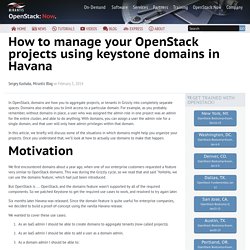
Domains also enable you to limit access to a particular domain. The DevOps Reading List: 10 Books & Blogs. By Team AppNeta on May 17, 2012 When you’re doing research and planning application development, it’s always useful to learn from the stories and experience of your peers.
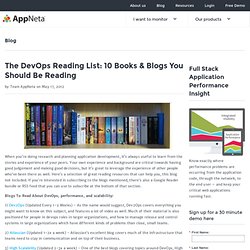
Is Node.js Really Faster Than Java? : java. Top_5_aws_ec2_performance_problems_ebook-1. BigData. Another comparison of HAProxy and Nginx « Affection Code. In my previous post about web application proxies, I compared HAProxy and Nginx performance when proxying a simple Rails application.

While HAProxy was able to serve pages faster and more consistently, the beanchmark also uncovered an apparent design flaw in HAProxy that caused some connections to hang around in the queue for a long time. HAProxy’s author, Willy Tarreau, quickly stepped in to attack the problem, and soon provided a new point release: My first analysis was that this problem was caused by “direct” requests (those with a server cookie) always being considered before the load balanced ones. Comparing Nginx and HAProxy for web applications « Affection Code. The last few days I have been comparing Nginx to HAProxy, with surprising results.

First, a bit of background. For a long time we at Bengler have been using Nginx as the main web server for our projects (1, 2), as well as to proxy Rails running under Mongrel. Nginx is a superb little open-source web server with a small footprint, sensible configuration language, modern feature set and buckets of speed. Cloud, Big Data and Mobile: Dissecting Amazon ELB : 18 things you should know. While designing highly scalable systems load balancing tier becomes an integral part of any architecture.
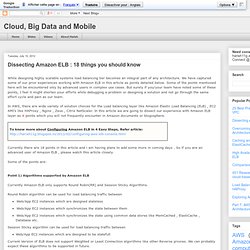
We have captured some of our prior experiences working with Amazon ELB in this article as points detailed below. Some of the points mentioned here will be encountered only by advanced users in complex use cases. But surely if you/your team have noted some of these points, I feel it might shorten your efforts while debugging a problem or designing a solution and not go through the same effort cycle and pain as our team.In AWS, there are wide variety of solution choices for the Load balancing layer like Amazon Elastic Load Balancing (ELB) , EC2 AMI’s like HAProxy , Nginx , Zeus , Citrix NetScaler.
In this article we are going to dissect our experience with Amazon ELB layer as X points which you will not frequently encounter in Amazon documents or blogosphere. Currently there are 18 points in this article and i am having plans to add some more in coming days . ELBs are great for HA but not for balancing load » Anybody with experience building scalable website has used load balancers in one form or another.
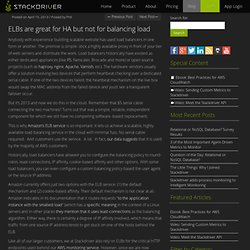
The premise is simple: stick a highly available proxy in front of your tier of web servers and distribute the work. Load balancers historically have existed as either dedicated appliances (like F5, Netscaler, Brocade and more) or open source projects (such as haproxy, nginx, Apache, Varnish, etc). The hardware vendors usually offer a solution involving two devices that perform heartbeat checking over a dedicated serial cable. If one of the two devices failed, the heartbeat mechanism on the live box would swap the MAC address from the failed device and you’d see a transparent failover occur. Complete LogStash stack on AWS OpsWorks in 15 minutes - Springest Devblog. 10 000 comet connections — Rasmus Andersson. Q: How well does the Nginx HTTP push module perform with 10 000 concurrent clients?

(Ye olde C10k problem). Linux Kernel Tuning for C500k. By Guest Blogger Sep 29, 2010 Like the idea of working on large scale problems? We’re hiring talented engineers, and would love to chat with you – check it out! Note: Concurrency, as defined in this article, is the same as it is for The C10k problem: concurrent clients (or sockets). At Urban Airship we recently published a blog post about scaling beyond 500,000 concurrent socket connections. SSD Cloud Hosting & VPS - MNX.io. Here at MNX, we’ve been busy setting up a brand new data center for our cloud hosted services.
We started off as a consulting company providing managed Linux services, which means we have been exposed to a ton of different customer environments and an equal number of schemes for naming equipment…not all of them good. It’s a problem that goes back as far as computers have existed, and everyone has their own opinion on the “best” way to name hosts. Most methods start out fine at the beginning, but quickly become unwieldy as infrastructure expands and adapts over time.
Since we’re starting fresh with this data center, we wanted to come up with our own naming scheme to address the common problems we’ve seen elsewhere. AWS OpsWorks: Lessons Learned. We’ve been using Amazon’s AWS OpsWorks to manage our infrastructure on a recent client project. The website describes OpsWorks as a DevOps solution for managing applications of any scale or complexity on the AWS cloud.
Scaling Instagram. Newsapps/beeswithmachineguns. New Relic Architecture - Collecting 20+ Billion Metrics a Day. This is a guest post by Brian Doll, Application Performance Engineer at New Relic. New Relic’s multitenant, SaaS web application monitoring service collects and persists over 100,000 metrics every second on a sustained basis, while still delivering an average page load time of 1.5 seconds. We believe that good architecture and good tools can help you handle an extremely large amount of data while still providing extremely fast service.
Here we'll show you how we do it. New Relic is Application Performance Management (APM) as a Service In-app agent instrumentation (bytecode instrumentation, etc.) Support for 5 programming languages (Ruby, Java, PHP, .NET, Python) 175,000+ app processes monitored globally 10,000+ customers. Building Five Labs. Posted on Tuesday, July 01 2014 in infrastructure What we Learned by Generating 200 Million Personalities in One Week The app we built went viral and generated personalities for over 200 million people. MySQL, AWS & Scalability Expert NYC. OnMetal: The Right Way To Scale. For big or rapidly growing Internet companies, one of the largest pains is scaling their application. Call me maybe: Elasticsearch. How we built our Real-time Analytics Platform » MaxCDN Blog. With the recent release of our Analytics Platform, we would like to give you a behind the scenes look of how we built it.
The amount of log data our worldwide network produces is staggering. Node.js in Production. When running a node application in production, you need to keep stability, performance, security, and maintainability in mind. Overcoming Outages in AWS : High Availability Architectures. Redis as the primary data store? WTF?! Scaling Asana.com - Asana Engineering Blog. Node.js w/1M concurrent connections! 600k concurrent HTTP connections, with Clojure & http-kit. 27 Jan 2013 Inspired by Scaling node.js to 100k concurrent connections! And Node.js w/250k concurrent connections!. AWS Tips I Wish I'd Known Before I Started. Scaling Mercurial at Facebook. Stackdock: Blazing Fast Docker-as-a-Service with SSDs – for $5. Node.js - hosting nodejs application in EC2. Node.js - nginx vs node-http-proxy. Hardening node.js for production part 3: zero downtime deployments with nginx. What is Capistrano? Hardening node.js for production part 2: using nginx to avoid node.js load.
Hardening node.js for production: a process supervisor. Scaling Pinterest - From 0 to 10s of Billions of Page Views a Month in Two Years. Scaling Mailbox - From 0 to One Million Users in 6 Weeks and 100 Million Messages Per Day. WebSockets – Varnish, Nginx, and Node.js. About – beanstalkd. Thoughts on message queue and work queue systems - overview & what's useful — jorgenmodin.net. ZeroMQ. OpenX on AWS. Travis CI heroku. Twitter Architecture. Database Scalability.